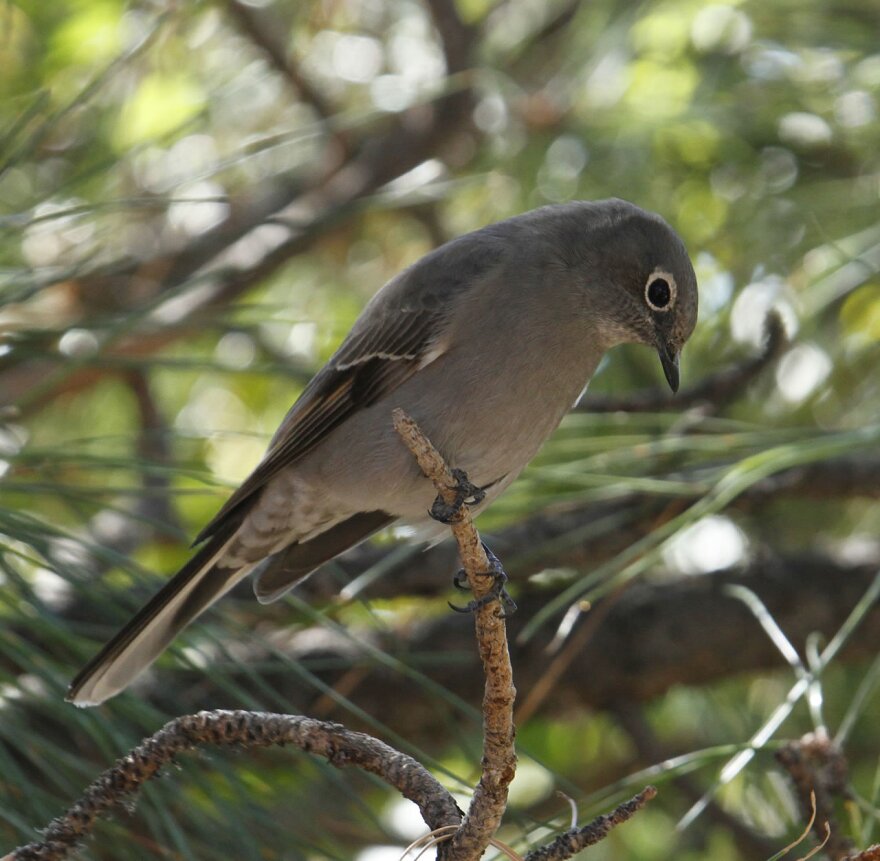When I feel the need to escape from town and immerse myself in the woods, I head up to Marshall Canyon, just east of Missoula, for a hike. Hiking along one of the old roads through the woods and taking in the fresh air and the views down the Clark Fork River towards Milltown soothe my soul and put things back into perspective. As I hike, I frequently hear what sounds like the squeak of a playground swing, swinging back and forth. This sound, however, is completely natural, the call of a somewhat drab-looking bird: a Townsend’s Solitaire.Solitaires are dull gray, medium-sized birds, slightly smaller and slimmer than American Robins. They are in the thrush family, which means they are related to robins and bluebirds, as well as hermit and Swainson’s thrushes. Their only remarkable field markings are the rings of white around their eyes and buffy patches on their wings. Both of these field marks are challenging to see unless you have binoculars or an exceptionally close view.
Townsend’s Solitaires are hard to find sometimes, but not uncommon—though this depends on where you are, of course. Their range includes most of the United States west of the Rockies. They typically live in high-elevation mountain forests, though in the winter they move down in elevation, and can be found around town. As their name says, they are generally solitary, and are usually seen alone. To spot one, look towards the tops of the trees for a gray bird, perched at attention, with good posture.
I’ve both heard and seen them along the river trail, within spitting distance of the University of Montana. Along with their shift in seasonal location comes a shift in diet. In the summer, solitaires eat invertebrates, such as insects and spiders, and a few berries. Come winter, their diet shifts almost exclusively to berries, specifically juniper berries.
Unlike many songbirds, who only establish and defend territories in the summer during breeding season, solitaires will defend territories in the winter as well, defending a particular patch of juniper berries. Studies have shown that solitaires with the largest winter territories, and therefore the most food, tend to survive the winter better, and have better reproductive success the following summer.
Townsend’s Solitaires are unusual too in that they sometimes sing during the winter, which helps them to defend their territories. To me, their song sounds like a highly caffeinated, ambitious robin. Solitaires have a lot to say, and they say it more eloquently than robins do. The solitaire’s song is long and complex, with clear warbling notes. It is made of “loud, melodious, fluty rising and falling phrases,” according to my field guide.
When I came face-to-face with a Townsend’s Solitaire along the river trail the other evening, it was not singing. It looked as startled to see me as I was it, though this could be entirely because of the bird’s white eye rings, which give it an “I’m-awake-now!” expression. We both poised, frozen, for a heartbeat or two before the solitaire flew across the path to a tree up against Mount Sentinel. I waited a few minutes for it to call or sing, but it was silent, a dark gray outline perched in the top of a pine. I turned to head back to campus, and to my school work. A few minutes down the trail, I heard a familiar playground-swing squeak, and I smiled as I continued on my way.
"Field Notes" is produced by the Montana Natural History Center.
(Broadcast: "Field Notes," 02/07/16 and 2/12/16. Listen on air or online Sundays at 12:55 p.m., Tuesdays at 4:54 p.m., and Fridays at 4:54 p.m., or via podcast.)

